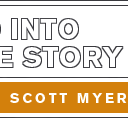I have this theory that there is something going on in terms of character archetypes in stories. We see five of them over and over again: Protagonist, Nemesis, Attractor, Mentor, Trickster.
The Protagonist represents a forward-moving dynamic, a character or characters most often driven by a conscious goal.
The Nemesis represents an oppositional dynamic, a character or characters pushing back against the Protagonist. Typically, this is the source of the story's central conflict.
The Attractor is a character most associated with the Protagonist's emotional life, someone or something connected to their heart.
The Mentor is a character most associated with the Protagonist's intellectual life, someone or something connected to their mind.
The Trickster is a shapeshifter, switching from a
Protagonist's ally to enemy... enemy to ally. They pursue their own ego-needs. If that aligns with the Protagonist's goal. great. If not, so be it.
Here is my take of the key characters in Spencer:
Protagonist: Diana. She is the story's central character. The story is told through her perspective. All the other characters are related to her storyline. Plus, she goes through the most significant personal metamorphosis.
Nemesis: The weight of expectations, Royalty. Oddly, Queen Elizabeth and Prince Charles don't have much in the way of page count, but their presence as the faces of royalty looms over Diana at every turn. Her existential choice -- What am I going to do -- revolves around them, especially Charles, whether to remain married to him or not. As her goal is freedom, they stand in her way. And the weight of expectations present in all of the public events Diana is supposed to attend over the Christmas weekend, are a constant presence, an overt oppositional dynamic.
Attractor: William and Harry. Her sons. She does have a connection to them as their mother.
Mentor: Clearly, Maggie (Diana's old dresser) is one. She is Diana's main adviser and dubs her "Diana the Free," one of the voices who encourages Diana to take her ultimate course of action. But there are two illusory / fantasy figures who also feed into Diana's eventual decision: (1) Young Diana who reminds Diana about who she once was -- youthful zeal and innocence -- which she can hope to reclaim. (2) Anne Boleyn, the former Queen who was beheaded. This ghostly figure not only suggests a negative path which could befall Diana (e.g., death, either physical or emotional), but also encourages her to act ("Go. Run. Live.")
Trickster: Major Gregory. There are moments where he expresses empathy, even sympathy for Diana, but almost invariably snaps to his default mode of behavior, loyalty to the Queen. Ultimately, that is his advice to Diana, thus, ending up in the enemy camp.
All of these characters have their role to play as part of the Family of Characters contributing to Diana's psychological transformation.
Tomorrow: Themes.
